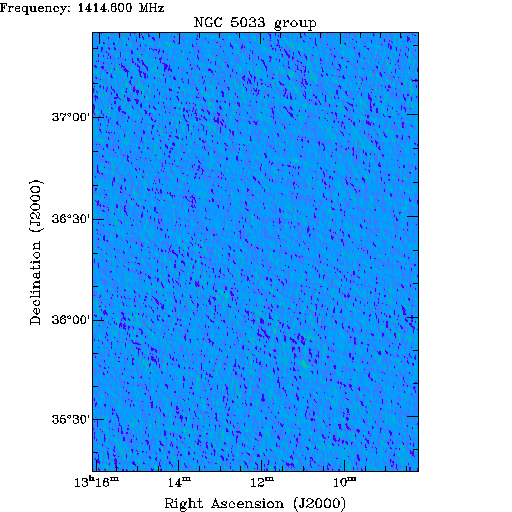Daily Image
13-11-2017Apertif imaging of the hydrogen in galaxies
| Submitter: | Tom Oosterloo (for the Apertif Commissioning Team) |
| Description: | Every weekend now, test observations are being performed with Apertif. Although the full system is not available yet (in terms of number of dishes, bandwidth, etc.), meaningful tests of the performance of the instrument and of the software can be done. One of the principal aims of Apertif is to survey very large regions of the sky to detect the atomic hydrogen in galaxies in order to find many many galaxies of all types and sizes, and to use this information to learn more about galaxy structure and evolution. In order to test the readiness of Apertif for such wide-field hydrogen observations, an observation was done pointing at a nearby group of galaxies, the group around the galaxy NGC 5033. This group has been studied with the old WSRT several times before, so a direct comparison between Apertif and the WSRT can be made. The movie loops through a small selection of frequency channels of the observing band, and shows the central 2 x 1.5 degree region of the full 3 x 3 degree field of view of the observation. Many images are empty (i.e. the wavy ocean blue), but in several channels, at several locations, hydrogen from a number of galaxies is detected (the red-white spots). The movie is the result of a single night of Apertif observing. With the old WSRT it would take about two weeks to cover the same field. All data were automatically calibrated and reduced with the Apertif pipelines. There are two reasons why the signal from the hydrogen from different galaxies is detected at different frequencies; and that also within a galaxy, the emission is spread over many frequency channels. One reason is the fact that the Universe is expanding. This means that while radiation is travelling from a galaxy to the telescope, the waves are stretched along the way, increasing the wavelength and thus lowering the frequency of the wave. The more distant a galaxy, the more the frequency changes. The second reason is that within a galaxy, gas from one part of a galaxy moves with respect to gas from other parts, for example because the gas reservoir in the galaxy rotates around its centre. Because of the Doppler effect, the radio waves from these different regions are detected at slightly different frequencies. These shifts are on top of those due to the Universal expansion. From these 'internal' shifts, one can derive how the gas moves in a galaxy, which tells a lot about the galaxy's internal structure. The movie covers only about 1/3 of the full field of view and only a small fraction of the final Apertif frequency band (4 MHz out of 300 MHz). Nevertheless, already 9 objects are detected (one of which is a cloud floating in between galaxies). So this observation demonstrates that each single, full Apertif observation will uncover the hydrogen in a few hundred galaxies. We plan to do more than a thousand of such observations, so we can be looking forward to detect about half a million galaxies... |
| Copyright: | Astron |
| Tweet |  |
